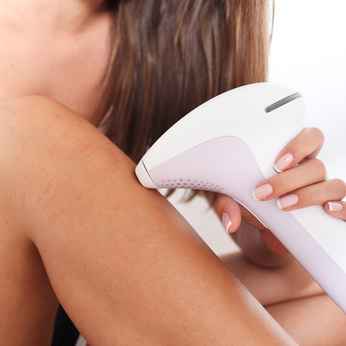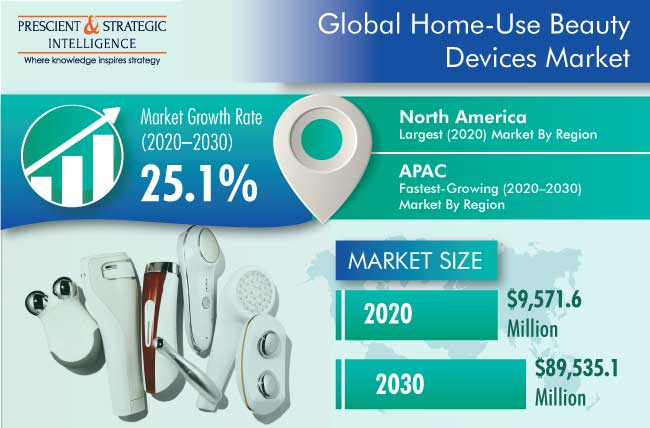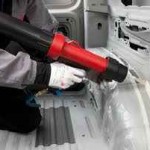Home-Use Beauty Devices Market to Reach $16.7Bn by 2023

Home-Use Beauty Devices Market Overview
The global home-use beauty devices market valued $5.5 billion in 2017 and is projected to witness a CAGR of 20.2% during the forecast period. Increasing prevalence of skin diseases, growing appearance consciousness in people and awareness about home-use beauty devices, and expanding product portfolio of market players are the key factors driving the market growth.
GLOBAL HOME-USE BEAUTY DEVICES MARKET, BY TYPE, $M (2013-2023)

Based on type, hair removal devices contributed $1.4 billion, accounting for 24.8% share to the home-use beauty devices market, in 2017. It is expected that the market share of these devices will reach 25.0% by 2023. The increasing awareness about technologically advanced hair removal devices and rising prevalence of hormonal disorders that result in unwanted hair growth are the key factors driving the growth of the market.
During the forecast period, the home-use beauty devices market is predicted to witness the fastest growth in Asia. Product innovation and presence of a large number of local players in the market are the factors contributing to the high demand for these devices in the region. Besides, the region includes fast-growing economies such as China and India, which are important markets for advanced beauty devices, including home-use devices.
The increasing penetration of multinational brands in the Asian home-use beauty devices industry and the introduction of affordable home-use beauty devices in the region are resulting in the increased adoption of these devices by end users for their grooming and personal care needs. Besides, low manufacturing cost and easy availability of cheap labor in the region is a key factor driving the growth of the market.
Home-Use Beauty Devices Market Dynamics
Trends
The growing penetration of home-use grooming devices for men is one of the key trends observed in the market. In recent years, the home-use beauty devices industry has witnessed introduction of men’s grooming devices by players such as Koninklijke Philips N.V. (Philips) and YA-MAN Ltd. For instance, Philips introduced a body groomer for men, for areas like thighs, calves, and armpits.
Growth Drivers
Increasing inclination of consumers toward easy-to-use home-use beauty devices, rising prevalence of skin diseases, and surge in disposable income are the factors driving the growth of the home-use beauty devices market. Excessive exposure to pollution and ultraviolet (UV) radiation results in skin problems such as sunburn, reduced elasticity, and hair loss. Skin diseases are also caused by various other factors such as excessive alcohol consumption and consumption of tobacco. Acne is the most common dermatological condition caused by the clogging of hair follicles by sebum, dirt, and dead skin cells. It affects the majority of the world’s population and often leads to scarring.
According to the American Academy of Dermatology (AAD), approximately 85% of Americans between the age of 12 and 24 years suffer at least from minor acne at some phase in their lives. Thus, in order to treat skin diseases and overcome harmful effects of UV radiation, advanced solutions are being introduced in the home-use beauty devices market.
Opportunities
Emergence of multi-functional devices is a growth opportunity for the players in the home-use beauty devices market. With the growing prevalence of skin diseases and other skin care-related conditions, multi-functional beauty devices are being increasingly adopted, globally. These devices feature more than one technology to treat several skin concerns, including wrinkles, acne, and aging. Some players have already introduced their product line of multi-functional devices in the market. For instance, in 2015, Micheal Todd LP, a U.S.-based beauty device manufacturer, introduced an anti-microbial cleansing system, Soniclear Elite, featuring collagen pulsating technology to fight aging.
Home-Use Beauty Devices Market Competitive Landscape
Continuous demand for new and innovative beauty devices has led to the introduction of several devices by the players in the home-use beauty devices market. For instance, in January 2018, Nu Skin Enterprises Inc. announced the consumer launch of ageLOC LumiSpa, the first-of-its-kind, dual-action skin care device that treats and cleanses the skin.
In January 2018, Carol Cole Company Inc. launched NuBODY, the first-ever USFDA-cleared microcurrent beauty device for the body. NuBODY is specially engineered to deliver a flow of targeted microcurrent to the larger and denser areas of the body. The device’s Micro-4 technology targets stubborn areas, such as the arms, stomach, and thighs, to smoothen dimpled and uneven skin.
Some of the other major players in the home-use beauty devices industry are TRIA Beauty Inc., Home Skinovations Ltd., The Procter & Gamble Company, iluminage Beauty Inc., Koninklijke Philips N.V., Spectrum Brands Holdings Inc., YA-MAN LTD., MTG Co. Ltd., and L’Oréal SA.

Kalyan Banga226 Posts
I am Kalyan Banga, a Post Graduate in Business Analytics from Indian Institute of Management (IIM) Calcutta, a premier management institute, ranked best B-School in Asia in FT Masters management global rankings. I have spent 14 years in field of Research & Analytics.







0 Comments